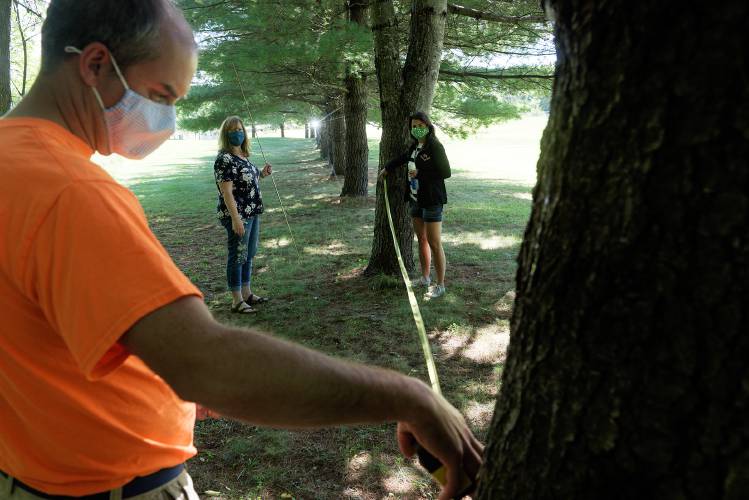Column: Vermont needs to address its entire education system

Dothan Brook School Principal Rick Dustin-Eichler helps fourth grade teachers Linda Gilbert, left, and Lanni West, right, measure their outdoor classroom space in Wilder, Vt., Friday, Sept. 4, 2020. Each grade at the school will have outdoor classroom space to be used as the weather allows as a precaution to keep students and staff safe from the novel coronavirus. “We’re seeing the value in (outdoor classes) a lot more,” said Dustin-Eichler. “That you’re not losing time when you come outside.” (Valley News - James M. Patterson) Copyright Valley News. May not be reprinted or used online without permission. Send requests to permission@vnews.com. Valley News — James M. Patterson
| Published: 04-19-2024 6:53 PM |
Vermonters love to talk about the weather. Regardless of the social situation, conversations rarely start without some reference to past, current or future conditions. As the old Mark Twain saying goes, “if you don’t like the weather in New England, wait a minute.” The unpredictable nature of Vermont’s weather makes great fodder for discussion, but the reality is that it also makes it difficult to prepare for the future with any certainty.
Educators have a similar but related conversation starter. Regardless of the location, when educators gather they love to compare notes about the initiative du jour and reassure each other that it too will pass: If you do not like today’s initiative, wait a minute. Teachers refer to this as the pendulum. Similar to Vermonters’ experience with regular unpredictable swings in the weather, seasoned educators’ experience with the ever changing initiative du jour also makes effectively preparing for the future impossible.
Staring into the gale of Vermont’s current education funding crisis, there is a crucial message that we must draw from this comparison. Changes in the educational landscape are impacting the field at a fast and furious rate. Like Vermont’s weather, these rapid shifts create a climate in which thoughtful, proactive planning is extremely difficult. Instead, schools are constantly adjusting to put out fires as they deal with rising health insurance costs, increased student mental health struggles, crumbling school infrastructure, declining enrollment, revisions to the school funding formula and declining COVID relief funds. Because each of these issues seems dire at the moment, educational leaders and policymakers become so enmeshed in solving each problem they fail to realize that these challenges are not one-off issues but the byproducts of a broken system.
The single issue solution narrative is reinforced by many of Vermont’s leaders. For example, in a letter to the editor former Jericho Legislator Floyd Nease argues that school consolidation is the key to remedying the crisis. Unfortunately, even though Nease recognizes that solving Vermont’s school funding crisis requires broad structural changes, he immediately jumps to a single solution; school closure and educator layoffs. Consolidation may play a role in the process, but addressing declining enrollment and crumbling school infrastructure must occur through a broader analysis of Vermont’s entire education system. Without broad change to the whole system, another storm will inevitably emerge requiring a new outlay of resources and funds.
The solution to the crisis rests in addressing teachers’ favorite topic head-on, the continuous swing of the initiative pendulum. The pace of change over the last 14 years has been rapid and is unsustainable. Since 2010, schools have worked to respond to multiple mandated changes in instructional approaches (i.e. the adoption of the Common Core State Standards, proficiency based learning, a new model for student supports and four different systems of school accountability, to name only a few) while also adapting to address significant decreases in student well-being which was exponentially magnified by the COVID-19 pandemic. Schools responded to this plethora of challenges with a determined effort and resolve, but two significant problems have emerged that directly impact school funding and student outcomes.
First, working within the limited school calendar (most schools have less than 10 professional development days per-year), there is not enough time to build, implement and sustain effective systems and instructional practices that align with the rapid roll-out of new state mandates. Every time a new initiative is mandated, school-based practices and systems need to go through significant revision to meet the state’s expectations. With little space between mandates, implementation plans are often scrapped midway through the process to realign the work with the newly mandated approach. Not only do these changes feed educators’ narrative around the swinging pendulum, but they also create frustration and decreased efficiency due to partial implementation. In addition, they waste valuable resources without improving student outcomes.
Second, underfunded and understaffed social service and community mental health agencies have forced schools to expand the scope of their work. This is built on the recognition that declining child well-being directly impacts students’ ability to access their education. Based on a February 2024 Legislative Education Costs Survey Summary, this expansion is expected to add almost $53 million to FY25 budgets as schools plan to hire social workers, therapists, psychologists, behavioral support staff and administrators to fill unmet student and community needs. To put this in perspective, based on the same report, new initiatives to support the maintenance of Vermont’s schools (the focus of Nease’s approach) was just under $39 million — $14 million less than mental health services. Is this new staffing justified? Absolutely, but it begs the question, does it belong in school budgets while similar services are available through other state agencies?
Navigating the complexities of school funding in these challenging times requires education leaders and policymakers to move away from gawking at their immediate local weather. They need to take a meteorologist’s perspective and start to examine how larger systems and patterns are affecting student learning and success. The goal of this is to move away from focusing on the issue du jour and develop a deep and lasting understanding of the broad role of education within Vermont, the systems that are required to support this charge and the funding necessary to achieve the desired end.
Article continues after...
Yesterday's Most Read Articles
Notice the funding comes last. Until there is a commonly agreed upon understanding of the role of public educational institutions in Vermont, it is impossible to create a funding system that truly produces the positive outcomes the state’s children deserve. Right now, the lack of a unifying and guiding vision allows the system to swing without direction, which creates inefficiency, confusion and frustration by educators and taxpayers alike. Taking a systems approach that honors the complexity of school funding and public education in general will require:
■Redefining the guiding vision for equitable education. The 1997 Vermont Supreme Court decision in Brigham v. the State of Vermont requires the Legislature to “achieve equity in educational financing.” However, it does not stop with the provision of equal funding. The opinion extends the ruling by connecting it to the U.S. Supreme court’s 1954 decision in Brown v. Board which states that equal access to educational opportunities is a “right which must be made available to all on equal terms.” Creating durable school financing change first requires a clear common vision for equitable schooling.
■With this new vision in hand, policymakers must work with Vermont’s educators to establish a research-based account of the on-the-ground staffing, programming and infrastructure that is required for Vermont’s schools to meet the articulated vision. This standard must go beyond providing a “minimally adequate” education as described in Brigham v. State of Vermont and seek to delineate the resources that are needed to provide a high quality, rigorous education to all students.
■Schools cannot shoulder the bulk of responsibility for supporting the positive and healthy growth of Vermont’s children. Structural and financial barriers between schools and other state and publicly financed community based agencies must be identified and removed to allow for easily accessible and proactive child and family supports. Eliminating the redundancy between schools and these agencies has the potential to significantly reduce school funding while improving outcomes. This must go well beyond the outdated framework described in Act 264 of 1988 — Coordinated Service Planning.
■Revise the state’s legislative and policy framework to ensure schools have the regulatory guidance, time and resources to fully implement Vermont’s vision for education. Schools cannot continue the ineffective practice of shifting priorities every time Montpelier’s pendulum swings. This harms students and is a waste of funding.
■In support of the vision for education and updated policy framework, lawmakers must use this information to 1. identify the true cost of providing every Vermont child with an equitable education, and 2. use this data to inform a revised school funding formula. The impact of all funding decisions must be scrutinized against their impact on the system as a whole to limit the siloed decision-making that produces negative systems-wide consequences.
We don’t need a weatherman to know which way the wind blows. The current financial crisis schools are facing is definitive proof there is no longer time to wait out the storm. Without significant systems-wide transformation, blue skies are not in the forecast and the pendulum is not going to swing the problems away. This is the time to transform the challenges of today into the holistic change required to build the successful and sustainable public education system that will endure future storms and deliver the outcomes Vermont’s children deserve.
Rick Dustin-Eichler has been an educator in Vermont for 21 years, the last 13 of them as principal at Hartford’s Dothan Brook School. He lives in Hartford.

 Editorial: Chris Sununu’s moral vacuum
Editorial: Chris Sununu’s moral vacuum Editorial: Gambling tarnishes America’s sporting life
Editorial: Gambling tarnishes America’s sporting life By the Way: A white nationalist’s many mistruths
By the Way: A white nationalist’s many mistruths Column: The age-old question of what to read
Column: The age-old question of what to read
